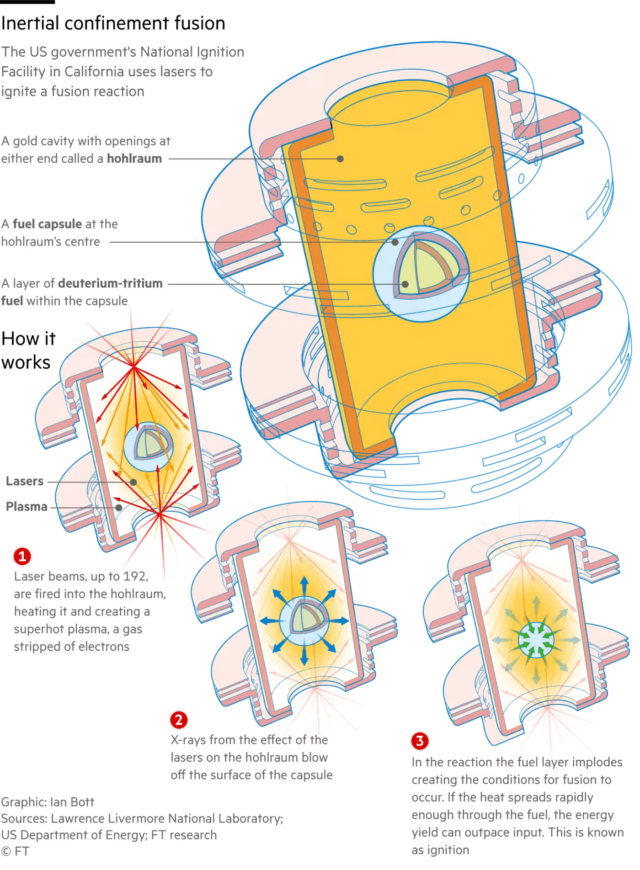Exciting news from US government scientists! They have achieved net energy gain in a fusion reaction for the second time, bringing us one step closer to the dream of limitless, zero-carbon power.
For decades, physicists have been working to harness the fusion reaction that powers the Sun. Until recently, no group had been able to produce more energy from the reaction than it consumes. But last year, researchers at the Lawrence Livermore National Laboratory in California achieved ignition for the first time. And now, they have repeated this breakthrough in an experiment on July 30, producing even higher energy output than before.
The laboratory has confirmed the achievement of energy gain at its laser facility and is currently analyzing the results. They plan to report these findings at upcoming scientific conferences and in peer-reviewed publications.
Fusion is achieved by heating two hydrogen isotopes to extreme temperatures, causing the atomic nuclei to fuse and release vast amounts of energy. The potential of fusion power is remarkable – it emits no carbon, produces no long-lived radioactive waste, and a small cup of hydrogen fuel could power a house for hundreds of years.
Advertisement
The most widely studied approach to fusion, known as magnetic confinement, uses huge magnets to hold the fuel in place while it is heated to temperatures hotter than the Sun. However, the NIF (National Ignition Facility) uses a different process called inertial confinement. They fire the world’s largest laser at a tiny capsule of fuel, triggering an implosion.

US Energy Secretary Jennifer Granholm hailed the achievement of ignition as “one of the most impressive science feats of the 21st century.” In the initial experiment, the reaction produced about 3.15 megajoules, which was 150 percent of the energy in the lasers.
Preliminary data from the July experiment indicates an energy output greater than 3.5 megajoules, which is roughly enough to power a household iron for an hour.
Achieving net energy gain is a crucial step in proving the feasibility of commercial fusion power stations. However, there are still challenges to overcome. The energy gain only compares the energy generated to the energy in the lasers, not the total energy required to power the system. Scientists estimate that commercial fusion will require reactions that generate between 30 and 100 times the energy in the lasers.
Despite these challenges, the improved result at the NIF, achieved just eight months after the initial breakthrough, is a promising sign that progress is accelerating.
© 2023 The Financial Times Ltd. All rights reserved. Not to be redistributed, copied, or modified in any way.
In a major milestone for the clean energy field, physicists at the Max Planck Institute for Plasma Physics in Germany have successfully achieved net energy gain in nuclear fusion for the second time. This accomplishment marks the culmination of years of effort and could potentially revolutionize energy production.
By initiating and controlling the fusion of two hydrogen isotopes, deuterium and tritium, the researchers generated a controlled, self-sustaining reaction, called a “plasma burn,” within their facility’s experimental two-megawatt reactor, known as the Wendelstein 7-X (W7-X). As the temperature of the plasma exceeded 100 million degrees Celsius, the researchers monitored the plasma’s behavior and managed to keep it from collapsing while simultaneously optimizing conditions for fusion.
“We must analyze the measurements from all components in order to understand these plasma processes better and to interpret the results correctly,” remarked researcher and the lead author of the study Dr. Thomas Sunn Pedersen. After completing a comprehensive review of the results, the researchers demonstrated that the reactor had achieved a ratio of energy produced from fusion to that of the external energy input of 1.
This breakthrough could ultimately help further the development of fusion reactors, which could potentially be deployed safely and securely on a mass scale to produce clean, virtually limitless, energy. Dr. Pedersen has noted, however, that greater control and the development of more efficient techniques are still needed. “The W7-X has the same features as a power plant but on a smaller scale,” he explained. “We are challenged to identify the right measures to achieve even better results.”
The arduous work that has gone into this achievement—including the careful fusion of deuterium and tritium, as well as the maintenance of conditions conducive to the plasma burn—represents a critical advancement, paving the way for further research into the potential of fusion energy. Indeed, this second success in achieving a net energy gain heralds a new era of green energy, of which the results are both encouraging and exciting.




















